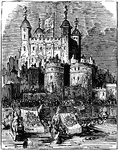Clipart tagged: ‘treasury’

Continental Draft
This is a thirty day sight draft bill of exchange for $24 / 120 livres tournois from the Continental…
!["Afterwards [Solon] went to Sardis and made the acquaintance of Cresus. It was on this occasion that the celebrated interview occurred which has been so much repeated for its lesson. Cresus, desiring to make an impression on his visitor, took him into his treasury and showed him his riches."—Ridpath, 1885](https://etc.usf.edu/clipart/78900/78916/78916_treasures_mth.gif)
Cresus Showing Solon His Treasures
"Afterwards [Solon] went to Sardis and made the acquaintance of Cresus. It was on this occasion that…

Reverse of a Massachusetts Treasury Note
In 1690, The Massachusetts Bay Colony issued the first paper money in the colonies, called Colonial…

Parthenon
The Parthenon is a temple of the Greek goddess Athena, built in the 5th century BC on the Athenian Acropolis.…

John Sherman
John Sherman nicknamed "The Ohio Icicle" (May 10, 1823 – October 22, 1900) was a U.S. Representative…

Procession to the Tower of London
Her Majesty's Royal Palace and Fortress, more commonly known as the Tower of London (and historically…

Traitor's Gate, Tower of London
The name Traitors' Gate has been used since the early seventeenth century, prisoners were brought by…



